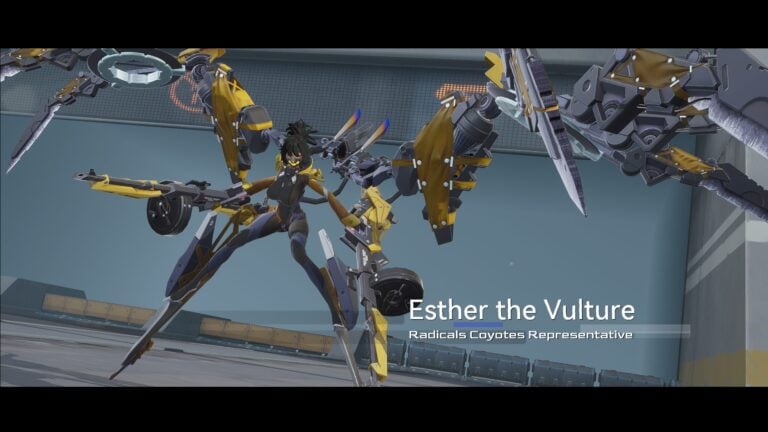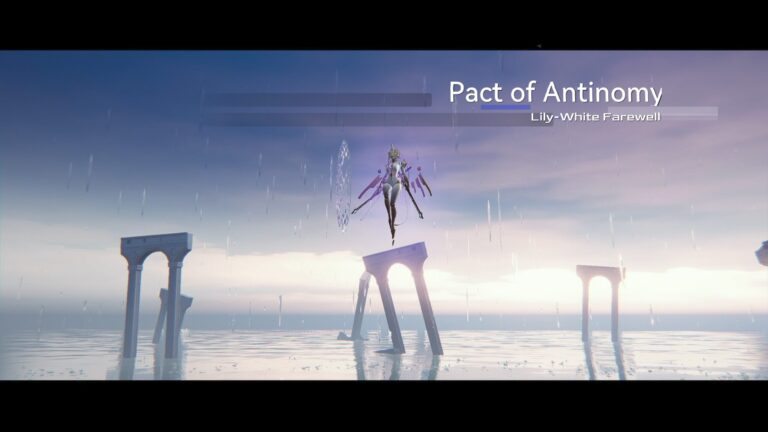Table of Contents
Neural Simulation (“Neural Sim” or “NS” for short) is a game mode where you fight one of two bosses that change weekly. Your goal is to defeat both bosses as fast as possible.
Basic Overview
The Neural Simulation menu can be found in the Dispatch section of the main mission menu.

Once in the menu, you’ll see the following UI elements:

- The two bosses on rotation in the current Neural Sim period, click on the boss you want to fight to switch to them
- Time left in the current Neural Sim period. Neural Sim periods always end at the same time on the daily reset of each new in-game week. After a Neural Sim period ends, this timer will instead count down the time until the next Neural Sim period opens. Neural Sim periods always begin at 2:00AM UTC on Tuesday (convert to your time zone)
- Boss description. The bottom of the boss description will list which Control effects it’s vulnerable to (though you can also find a full table of which bosses are vulnerable to which Control effects further down on this page).
- The current difficulty level of the selected boss. Difficulty levels start at one and reach a maximum of five, and are independent of the difficulty level of the other boss. Once you go up a difficulty level for a boss, you can not go down difficulty levels for that boss in the current period (not that there’s any reason to).
- Evaluation attempts remaining. Clearing the first four difficulty levels of a boss requires an evaluation attempt to be consumed. You will have a limited number of evaluation attempts for the first day of the Neural Sim period only; you will have enough to clear the first four difficulty levels for both bosses from the second day onward. Attempting difficulty level five for a boss does not require evaluation attempts.
- The lineup of characters and equipment that has produced the highest-scoring run for that boss.

Clicking on the lineup will bring up a menu with more details. Keep in mind what you have used on a certain boss is very important, as everything used (operatives, weapons, and logistics pieces) can no longer be used on the other boss during the same Neural Sim period unless another run with a different lineup is confirmed for the first boss.

This run does not have to score higher than the existing one.

If you have not fought the boss yet, the lineup will be blank, obviously.
- Buttons to proceed towards fighting the boss or performing a Quick Evaluation. Quick Evaluation will automatically clear a boss that is at one of the first four difficulty levels and grant you the associated score. Quick Evaluation cannot be used on Difficulty V bosses.
- The Neural Sim rewards menu. Here you can view and collect rewards for completing Neural Sim clears, as well as view your placement on the ranking leaderboard along with the rewards for each ranking bracket.

- The Neural Sim shop, where you can use the rewards obtained to purchase various items. You can also access this shop via the main shop interface from the home menu.
Special Modifiers

Neural Sim battles have unique modifiers that will affect the stats of your operatives. These effects change every week, and include both individual modifiers for each boss, as well as a single modifier for the week that affects both boss battles. Before you fight a Neural Sim boss, it’s important to know what modifiers are in effect for that battle and plan accordingly if necessary.
As well, bosses will gain upgrades to their abilities to make them more difficult or time-consuming to battle. These upgrades are unique to each boss but stay the same between appearances.
As you go up in difficulty level, more modifiers will take effect, and the boss will gain access to more upgrades.
Scoring and Ranking
For the first four difficulty levels of a boss, the score obtained from clearing that difficulty level is a set amount regardless of the time taken to clear. However, Difficulty V works differently. The maximum score possible is 40,000 but with your score decreasing by 100 for every second taken to defeat the boss. For example, killing a boss in exactly 60 seconds will subtract 60×100=6,000 points from 40,000 to produce a score of 34,000. Therefore, achieving victory as quickly as possible is important to obtaining high scores and ranking placements.
Strategy
Neural Sim is a score-based game mode, with higher scores correlating to faster fights. Thus, Neural Sim requires a slightly different mindset compared to general content, which is typically much easier. Since you will be exclusively fighting bosses, there are also other things that should be taken into account.
Control Effects
Bosses in Snowbreak have a period of time (roughly 14 seconds) where they cannot be affected by a Control effect after one is applied.

This lockout period is visually represented by a golden yellow bar underneath the main boss health bar, which depletes over time until disappearing to signify that the lockout period is over. The lockout also does not begin counting down until the Control effect expires.
Furthermore, not all Control effects work on all bosses. Most bosses are only vulnerable to two types of Control effects at most:
| Control Effect | Generally Affected Groups | Specific Bosses Affected |
| Stun | Humans | Esther, Sartre, Will (both variants), Katya (both variants), Gavin, Joseph (both variants) |
| Freeze | Titans | Beauvoir 13, Hela (both variants), Fiend - Foehn, Njall (both variants), Lament of Yehrus, Nightborne Phantom, Snowbreak Aku-MA |
| Paralyze | Mechanical Enemies | Ni-Type Mech (both variants), Cerberus, Teumessian, Joseph - Hardened, pi - Purified |
| Slow | All | All except Snowbreak Aku-MA |
Note that every Neural Sim boss can be affected by Slow with the singular exception of Snowbreak Aku-MA, which makes operatives who can effectively apply it universally useful.
Team Building
In the current meta, teams consist of one main DPS operative and two supports. This is because it is much more efficient to focus on buffing up a single DPS than it is to spread power between multiple.
DPS
When selecting a DPS operative, it is important to take into account what supports you can pair with them, the boss that is being fought, and any relevant weekly modifiers. For example, you probably shouldn’t bring Yao - Winter Solstice to a boss with Thermal resistance on the weekly modifiers list.
While you can make do with most DPS operatives, there are a few worth mentioning as the top performers:
 Yao - Winter Solstice | Yao is one of if not the best operative for many of the bosses you’ll see in Neural Sim, and at least usable in all the others. To extract top performance out of her though, you’ll want to put her with Mauxir - Shadow Ka and Tess - The Magician whenever possible. |
 Chenxing - Ethereal Cloud | A very strong all-rounder, Chenxing especially excels against bosses with multiple parts that she can lock onto with her standard skill. This makes her particularly effective against Cerberus, Fiend, and her main claim to fame, Hela, who gets ripped to shreds. |
 Fenny - Coronet | While still a very strong DPS pick, Coronet finds herself sometimes being overshadowed by other operatives and can struggle to keep her gun loaded with ammo given its sequential loading. |
 Katya - Blue Bolt | Very similar to Chenxing in that she’s a strong generalist DPS. Katya benefits from never having to reload but also can have issues tracking more mobile bosses given that her crossbow projectiles are not hitscan. |
 Fritia - Hush | A high-investment operative that eventually pays off with some of the fastest Neural Sim clears in the game. Requires Tess to be effective. |
 Lyfe - Wild Hunt | Hybrid gun/skill damage operative. Like Hush, she also requires heavy investment. |
 Marian - Swift | Another high-investment operative, Swift can be especially strong against mobile bosses due to her ability to lock onto her target. |
 Haru - Absconditus | While not useful for most bosses in the game, Haru earns a special mention given her effectiveness against Fiend when equipped with Star Ocean. |
 Cherno - Enigma | Provides very strong, sustainable burst damage delivered via skills and not shooting. |
 Siris - Ksana | Strong, sustainable burst damage that scales up over time. |
 Lyfe - Infinite Sight | Strong Kinetic DPS that's highly mobile and capable of locking onto enemies. |
 Vidya - Agave | Limited viability as a DPS outside of her designated pandering boss, Nightborne Phantom. |
Supports
Once you select your DPS, you will ideally pick two supports to bring out their potential and allow your DPS to do as much damage as quickly as possible. Keep operative synergies in mind too!
There are a lot of options available to you, perhaps more than you initially thought. Here’s a quick rundown of the common ones you might consider, though this isn’t an exhaustive list:
| Operative | Primary Role | Additional Notes |
 Tess - The Magician | U-Energy Battery | The vast majority of Tess’ usefulness is in her ability to generate large amounts of U-Energy. It is generally not recommended to use her if this niche is not required, as other supports will most likely provide more value. |
 Mauxir - Shadow Ka | Offensive Utility | While Mauxir doesn’t directly buff the DPS outside of her passive, she provides a stationary target linked to the targeted enemy’s health which can also come with guaranteed crits to shots made at it. |
 Lyfe - Wild Hunt | Buffer | When equipped with Alloy Truth and Amarna Squad, Lyfe can become a very strong damage buffer due to her support skill being able to activate both parts of Amarna’s effect. She can also apply Freeze to most Titan bosses. |
 Acacia - Kaguya | Debuffer/Buffer | Provides universal resistance shred, which will always be useful. Kaguya can also make use of Amarna Squad exceptionally well, allowing her to pull double-duty as a buffer too. |
 Chenxing - The Observer | Buffer/Healer | While Chenxing’s support skill provides a heal, her primary usefulness comes from the skill damage buffs that come with it. |
 Acacia - Redacted | Debuffer | The best Slow applier in the game. Acacia also provides starting U-Energy, which can be useful to certain DPS operatives. |
 Lyfe - Wednesday | Debuffer | Can apply Paralyze. |
 Fritia - Little Sunshine | Buffer | The aptitude effect from her support skill is especially potent with shotgun operatives. Her Deiwos passive that increases damage dealt to burning enemies has great synergy with Yao - Winter Solstice. |
 Enya - Big Sis | Buffer | While her time in the spotlight has long since passed, Enya can still find niche use with sniper operatives if all other options are already exhausted. |
 Cherno - Those Two | Debuffer | The other main Slow applier. Not as universally usable as Redacted, but she can equip Alloy Truth and is good enough against melee bosses to be worth considering. |
 Yao - Quiet Quitter | Healer | See “A Quick Note on Healers And Other Defensive Supports” |
 Siris - The Goldfish | Defensive Utility | See “A Quick Note on Healers And Other Defensive Supports” |
 Eatchel - The Cub | Healer/Buffer | Can provide very strong attack buffs in extended fights. Otherwise, see “A Quick Note on Healers And Other Defensive Supports” |
 Enya - Exuvia | Sub-DPS/Buffer | Provides strong skill damage buffs, but also has extra synergy with certain DPS operatives. Her support skill can also provide interruption resistance. |
 Fenny - Starshine | Ballistic Damage Support | Provides extra ammo and ballistic damage buffs, giving her strong synergy with ballistic damage DPS units. |
 Vidya - Agave | Debuffer/Buffer | Can apply Paralyze, and provides a small attack boost on top. Not worth using as a pure attack buffer. |
A Quick Note on Healers And Other Defensive Supports
Neural Sim does not reward you for clearing with extra health. In fact, there is a weekly modifier that may show up which reduces your damage while over half health, so you may find that not taking damage is actually a demerit in some cases. Either way, there’s no reason to worry about taking damage as long as the attack doesn’t stagger or knock back the active operative (time loss) and none of your operatives die.
This means that healers and other defensive supports should only be used if absolutely necessary, and more offensive supports that directly buff your active operative or debuff the enemy are always preferred when possible.
Parts Breakers
For some bosses, it will be necessary to break parts on them to progress the fight. In general, shotgun operatives will be ideal for this due to their innate high parts break rate. There are a few other options, though, each with their own benefits:
 Fenny - Lionheart | - Has built-in mobility to enter combat range faster - Support skill can replenish ammo for the main DPS |
 Fenny - Coronet | - Passive can provide an extra shotgun pellet per shot, allowing for potentially faster parts breaking - Support skill can boost the main DPS’s rate of fire as well as her own for faster parts breaking if swapped in after casting - DO NOT use active skill if parts breaking, it will reduce her parts break rate |
 Nita - Hands | - Support skill can provide mobility to enter combat range faster |
 Siris - The Goldfish | - Support skill can provide aptitude effects |
 Katya - Blue Bolt | - Manifest 2 provides her with extra parts breaking power, potentially allowing her to double as a parts breaker and main DPS |
 Yao - Winter Solstice | - Standard skill allows her to quickly fire multiple shots with the sniper parts break rate in situations where not many parts need to be broken |
 Tess - The Magician | - Ultimate ability can provide follow-up shots for additional parts break |
 Eatchel - The Cub | - Ultimate ability can also provide instant parts break |
 Vidya - Agave | - Parts break specialist that can break parts with her standard skill - Standard skill can damage up to two parts at once |
When looking to deploy an operative for parts breaking purposes, also remember to equip any weapon attachments that provide parts breaking boosts. It can mean the difference between breaking a part or needing an extra shot.
Logistics Sets
For DPS operatives, they will usually just use the set that they normally use, but supports have a bit more diversity in their options:
| Logistics Set | Role | Additional Notes |
| Xinye | U-Energy Generation | Niche usage |
| Twilight | Debuffing | Requires the equipped operative to be of the same element as the DPS to be effective |
| Navigator | Debuffing | Only useful on supports capable of applying Control |
| Amarna | Buffing | Requires continuous damage from support skill for maximum effectiveness |
| Phantom | U-Energy Generation | Niche usage |
Support Weapons
Support weapons generally fall under three categories: attack boosters, resistance shred debuffers, and U-Energy generation boosters. Attack buffers are generally the preferred choice, but the other options may still be useful if that is not an option.
| Weapon Effect | Weapons | Additional Notes |
| Attack boost | Wave, Frigatebird, Deep Sea’s Call, Lapis Lazuli, Prismatic Igniter, Strawberry Shortcake, Trial’s Eve, Alloy Truth | Wave is event-exclusive and scales off of the equipped operative’s HP rather than ATK unlike most the others in this group. Trial’s Eve also scales off the active operative’s ATK, rather than the equipping operative’s ATK. Alloy Truth gets a special mention as arguably the best support weapon in the game, providing a large ATK buff scaling with max HP, as well as a crit damage boost. |
| Resistance shred | The Past’s Sigh (SMG, Kinetic), Disco Confusion (Chaos, Sniper), Valkyrie 2056 (Thermal, Shotgun), Aye Aye Captain (Frost, Pistol), Duckling (Electric, AR) | Each weapon will reduce the resistance for a different element, which may make it difficult to bring the right one. Damage also has to be dealt by the equipped operative’s support skill to activate the weapon effect. |
| U-Energy Generation | Eccentric Joker, Wasp, Odd Alley Cat | Eccentric Joker and Wasp have limited usefulness when not equipped to Tess. |
Know Your Enemy
Being familiar with a boss’ attack patterns, phase changes and their HP thresholds, and other quirks they might have is important to being able to defeat them as quickly as possible. Don’t be afraid to rerun a boss to figure out what attacks you have to dodge and which ones you can sidestep or facetank, or to see how long you can spend attacking before you have to dodge an attack.


















